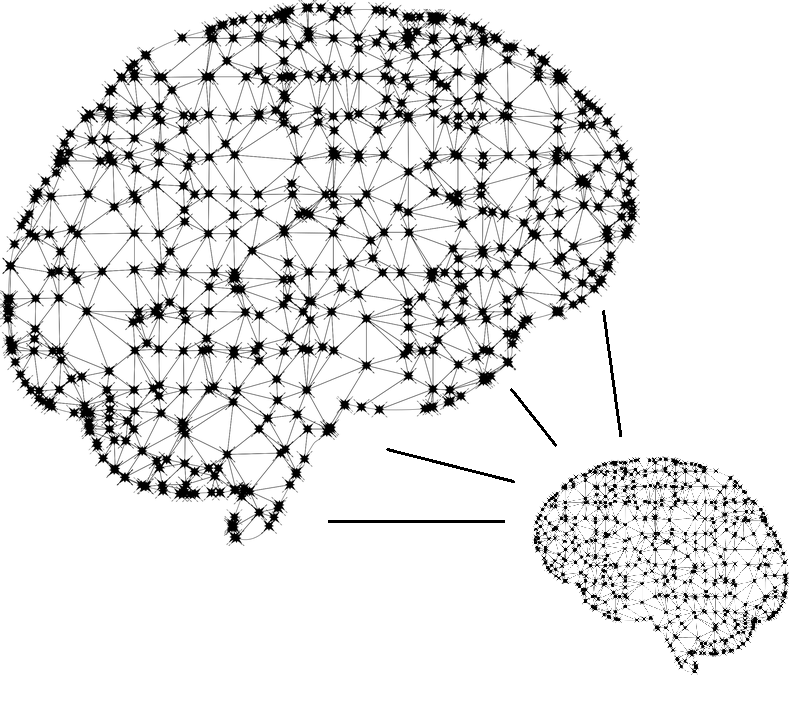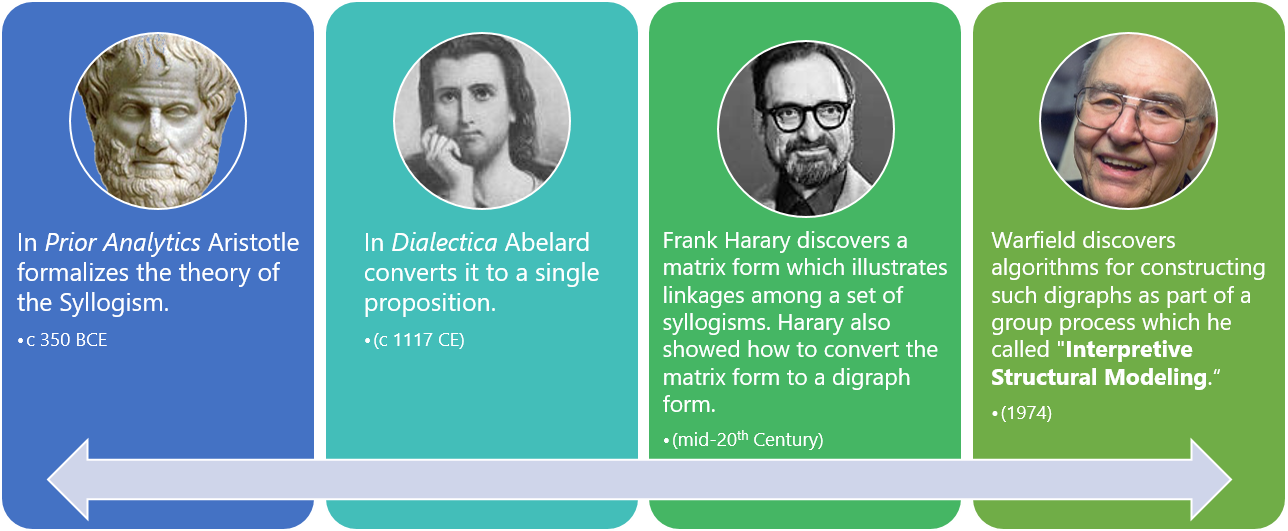
Main Menu Items (12)
This site is maintained by the Warfield Intellectual Property Trust. To send us a message, please fill out the form below.
{pagebuilderck 2}
UNDERSTANDING COMPLEXITY: THOUGHT AND BEHAVIOR
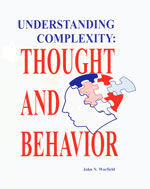

Integrating the material in several earlier books, this book explains how complexity can be resolved by the use of processes that are designed in the full light of two sets of scientific literature:
The literature on formal logic: (Aristotle, Abelard, De Morgan, Boole, Peirce, Harary, Warfield)
The literature on behavioral pathologies of individual, groups, and organizations: (Alberts, Allison, Argyris, Bales, Boulding, Cardenas, Downs, Foucault, Janis, Lasswell, Miller, Simon, Tuckman, Warfield)
The book shows how processes that incorporate the research results from these two literatures have been applied repeatedly in government, industry, religion, and universities to resolve complexity. Specific instances of successful applications of Systems Science are described in detail.
The concept of complexity is interpreted comprehensively. Various metrics of complexity are defined, modes of computing their values are given and values from applications are shown. Dr Warfield presents the Twenty Laws of Complexity that he has compiled, explaining their use in organizations. Warfield explains how commonly-made assumptions prevent resolution of complexity. The book contains numerous drawings and tables and provides a detailed index.
Please visit the Book Store for more information on how to purchase this book.
THE MATHEMATICS OF STRUCTURE


In Warfield's 1976 book titled Societal Systems: Planning, Policy, and Complexity, published by Wiley Interscience Systems Engineering Series (Harold Chestnut, Editor), he presented an integrated sequence of chapters on what he has since labeled as "the mathematics of structure". It was in this book that he introduced a computer-assisted group process called "Interpretive Structural Modeling."
The mathematics that provided the basis of concepts presented in Societal Systems were inadvertently camouflaged by residing within the larger text; therefore, Warfield decided to extract this information and publish The Mathematics of Structure as a separate text in the year 2003.
Chapter titles:
- Boolean Algebra, Sets, and Binary Relations
- Binary Matrices and Matrix Models
- Digraphs, Digraph Maps, and Digraph Models
- Structure and Complexity
- Cycles
- Interpretive Structural Modeling (ISM)
Within the first three chapters, this book offers the foundational mathematics of structure.
The last three chapters show how computer-assisted model construction can assist in taking advantage of the aggregated and integrated beliefs of well-informed (and partially-informed) groups of actors (meaning individuals taking action).
The middle chapter, "Structure and Complexity," explains how applications of the mathematics of structure enable insights to be developed about problematic situations - insights that will not be discovered using methods that are less scientific.
Please visit the Book Store for more information on how to purchase this book.
AN INTRODUCTION TO SYSTEMS SCIENCE


A HANDBOOK OF INTERACTIVE MANAGEMENT
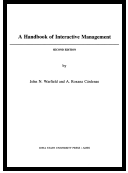
 With minor exceptions, this collection of PDFs contains the material in the second edition of the following book:
With minor exceptions, this collection of PDFs contains the material in the second edition of the following book:
J.N. Warfield and A.R. Cardenas (1994), A HANDBOOK OF INTERACTIVE MANAGEMENT, 2ND Ed., Ames, IA: The Iowa State University Press (ISBN 0-8138-2407-9).
Because this book is now out of print, the original manuscript is available for free download in PDF format. The book contains about 350 pages in 8.5 X 11 inch format, which accommodates quite a few detailed drawings. Included in the scanned files are: are short preface, a list of figures, a list of tables, a bibliography, an index to topics, an index to names, and an index to organizations.
Chapter Titles:
- What is Interactive Management?
- Interactive Management Outcomes
- Interactive Management Success Levels
- Interactive Management Roles
- Interactive Management Products (Application Structural Types)
- Interactive Management Processed
- Demosophia Facility (Situation Room for Interactive Management)
- Interactive Management Software
- Interactive Management Planning Phase (Phase 1)
- Interactive Management Workshop Phase (Phase 2)
- Interactive Management Follow-Up Phase (Phase 3)
- Evaluation Criteria for Interactive Management Applications
- Comparing Interactive Management with Methods Widely used in Japan
Appendices:
- Executive Overview of Interactive Management
- GMU ISM Software
- Group Facilitation
- Case Study: Definition of Analytical Powertrain
- Qualified Interactive Management Practitioners
- The Interactive Management Workshop Plan
Societal Systems: Planning, Policy, Complexity
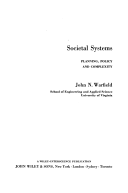

A Science of Generic Design: Managing Complexity through Systems Design
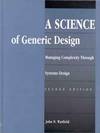

Synthesis of Linear Communication Networks
Translated from the German by G.E. Knausenberger and J.N. Warfield
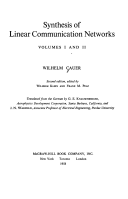

Introduction to Electronic Analog Computers


Principles of Logic Design
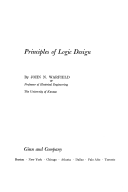

Categories
From this page you may browse the Catalog of Dr. Warfield’s work, which includes over 2,000 entries, including books, videos, presentations, and published and unpublished papers. Many are available for free download.
There are several ways to view the Catalog. You can do a text search using the "Search" field at the top of the page. You can also search by attributes such as Author or Media, using the search panel to the left, or the "Advanced Search" tab.
For a "Guided Tour" of Dr. Warfield's most important works, please see the following articles:
Our goal is to ensure the John N. Warfield intellectual legacy remains widely available.
Dr. Warfield did much of his later work at George Mason University in Fairfax, Virginia, USA. He later donated the originals of many of his documents to GMU's Special Collections and Archives. The collection is cataloged for online review and is open to visitors.
John Warfield: Scientist, Inventor and Teacher
Dr. Warfield is best known as the inventor of Interpretive Structural Modeling (ISM), Interactive Management and Generic Design Science.
Interactive Management and ISM software have been applied by practitioners around the globe to large-scale, difficult problems in industry and government, ranging from automotive design at Ford, to DoD procurement, to government policy at every level.
In Understanding Complexity: Thought and Behavior, Dr. Warfield defined Interactive Management as "a system of management invented explicitly to apply to the management of complexity. It is intended to be applied intermittently in organizations to enable those organizations to cope with issues or situations whose scope is beyond that of the normal type of problem that can readily be solved."
During his distinguished career, Dr. Warfield published five books and more than 100 papers on topics including computers, software, systems, organizations, electrical networks, Interactive Management and generic design science.
Use this link to visit Ajar Publishing:
Warfield was the author of more than 10 books and 100 papers. His books:
- 1958. Synthesis of Linear Communications Networks. with G. E. Knausenberger, New York: McGraw-Hill.
- 1959. Introduction to Electronic Analog Computers. Englewood Cliffs: Prentice-Hall.
- 1963. Principles of Logic Design. Boston: Ginn and Company.
- 1976. Societal Systems: Planning, Policy, and Complexity. New York: Wiley Interscience.
- 1990. A Science of Generic Design: Managing Complexity through Systems Design. Ames, IA: Iowa State University Press 1994.
- 1994. A Handbook of Interactive Management. With Roxana Cárdenas, Ames, IA: Iowa State University Press 1994.
- 2002. Understanding Complexity: Thought and Behavior. AJAR Publishing Company, Palm Harbor, FL.
- 2003. The Mathematics of Structure. AJAR Publishing Company, Palm Harbor, FL.
- 2006. An Introduction to Systems Sciences. World Scientific, Singapore
Articles, papers and monographs, a selection:
- 1956. Systems Engineering. United States Department of Commerce PB111801.
- 1957. "How to Improve Systems Engineering". Aeronautical Engineering Review, 16(7), July, 1957, 50-51.
- 1969. "What is System Planning?". With R.W. House, in: Automatica Vol. 5, 1969, pp. 151–157.
- 1972. A Unified Systems Engineering Concept. With J. D. Hill, et al., Columbus: Battelle Memorial Institute, Monograph No. 1, June, 1972.
- 1974. Structuring Complex Systems. Columbus: Battelle Memorial Institute Monograph No. 4, April, 1974
- 1987. "Dimensionality" with Alexander Christakis Systems Research 4, pp. 127–137
- 2003. "A Proposal for Systems Science". In: Systems Research and Behavioral Science, Vol. 20 (2003), pp. 507–520.
- 2003. "Autobiographical Retrospectives: Discovering Systems Science". In: International Journal of General Systems, December 2003 Vol 32 (6), pp. 525–563.

Much of Dr. Warfield's work and those of his colleagues is available in the Guide to the John N. Warfield papers of the Fenwick Library at George Mason University, (GMU), Fairfax, Virgina. The work cannot presently be downloaded, but the extensive collection is indexed.
It includes books, papers, compact disks, videos, audio disks, and several hundred transparencies.
The GMU site also contains information on how to contact the GMU special collections staff for more information.
GMU also hosts a digital collection of Dr. Warfield's work, from which many items may be downloaded for free.
An exhibit depicting the life and work of Dr. Warfield was on display at the Fenwick Library in 2013. GMU has preserved this display in a digital archive.
UNDERSTANDING COMPLEXITY: THOUGHT AND BEHAVIOR


Integrating the material in several earlier books, this book explains how complexity can be resolved by the use of processes that are designed in the full light of two sets of scientific literature:
The literature on formal logic: (Aristotle, Abelard, De Morgan, Boole, Peirce, Harary, Warfield)
The literature on behavioral pathologies of individual, groups, and organizations: (Alberts, Allison, Argyris, Bales, Boulding, Cardenas, Downs, Foucault, Janis, Lasswell, Miller, Simon, Tuckman, Warfield)
The book shows how processes that incorporate the research results from these two literatures have been applied repeatedly in government, industry, religion, and universities to resolve complexity. Specific instances of successful applications of Systems Science are described in detail.
The concept of complexity is interpreted comprehensively. Various metrics of complexity are defined, modes of computing their values are given and values from applications are shown. Dr Warfield presents the Twenty Laws of Complexity that he has compiled, explaining their use in organizations. Warfield explains how commonly-made assumptions prevent resolution of complexity. The book contains numerous drawings and tables and provides a detailed index.
Please visit the Book Store for more information on how to purchase this book.
THE MATHEMATICS OF STRUCTURE


In Warfield's 1976 book titled Societal Systems: Planning, Policy, and Complexity, published by Wiley Interscience Systems Engineering Series (Harold Chestnut, Editor), he presented an integrated sequence of chapters on what he has since labeled as "the mathematics of structure". It was in this book that he introduced a computer-assisted group process called "Interpretive Structural Modeling."
The mathematics that provided the basis of concepts presented in Societal Systems were inadvertently camouflaged by residing within the larger text; therefore, Warfield decided to extract this information and publish The Mathematics of Structure as a separate text in the year 2003.
Chapter titles:
- Boolean Algebra, Sets, and Binary Relations
- Binary Matrices and Matrix Models
- Digraphs, Digraph Maps, and Digraph Models
- Structure and Complexity
- Cycles
- Interpretive Structural Modeling (ISM)
Within the first three chapters, this book offers the foundational mathematics of structure.
The last three chapters show how computer-assisted model construction can assist in taking advantage of the aggregated and integrated beliefs of well-informed (and partially-informed) groups of actors (meaning individuals taking action).
The middle chapter, "Structure and Complexity," explains how applications of the mathematics of structure enable insights to be developed about problematic situations - insights that will not be discovered using methods that are less scientific.
Please visit the Book Store for more information on how to purchase this book.
AN INTRODUCTION TO SYSTEMS SCIENCE


A HANDBOOK OF INTERACTIVE MANAGEMENT

 With minor exceptions, this collection of PDFs contains the material in the second edition of the following book:
With minor exceptions, this collection of PDFs contains the material in the second edition of the following book:
J.N. Warfield and A.R. Cardenas (1994), A HANDBOOK OF INTERACTIVE MANAGEMENT, 2ND Ed., Ames, IA: The Iowa State University Press (ISBN 0-8138-2407-9).
Because this book is now out of print, the original manuscript is available for free download in PDF format. The book contains about 350 pages in 8.5 X 11 inch format, which accommodates quite a few detailed drawings. Included in the scanned files are: are short preface, a list of figures, a list of tables, a bibliography, an index to topics, an index to names, and an index to organizations.
Chapter Titles:
- What is Interactive Management?
- Interactive Management Outcomes
- Interactive Management Success Levels
- Interactive Management Roles
- Interactive Management Products (Application Structural Types)
- Interactive Management Processed
- Demosophia Facility (Situation Room for Interactive Management)
- Interactive Management Software
- Interactive Management Planning Phase (Phase 1)
- Interactive Management Workshop Phase (Phase 2)
- Interactive Management Follow-Up Phase (Phase 3)
- Evaluation Criteria for Interactive Management Applications
- Comparing Interactive Management with Methods Widely used in Japan
Appendices:
- Executive Overview of Interactive Management
- GMU ISM Software
- Group Facilitation
- Case Study: Definition of Analytical Powertrain
- Qualified Interactive Management Practitioners
- The Interactive Management Workshop Plan
Societal Systems: Planning, Policy, Complexity


A Science of Generic Design: Managing Complexity through Systems Design


Synthesis of Linear Communication Networks
Translated from the German by G.E. Knausenberger and J.N. Warfield


Introduction to Electronic Analog Computers


Principles of Logic Design


Systems Science: "Thought About Thought"
For more than three decades Dr. Warfield studied systems and complexity. The product of his intense effort was the creation of Systems Science, described in "A Proposal for Systems Science" published in Systems Research and Behavioral Science in December 2003.
His research concluded that systems science is a hierarchy of sub-sciences, all of which incorporate the "Fundamental Triangle of All Science."
This Triangle consists of the human being, thought about thought, and language. Because most authors involve the three vertices of this triangle intuitively in their work, they make a variety of unsubstantiated assumptions related to them.
When complexity is involved, these assumptions typically misdirect their work, which explains why, after a century of study, no systems science had been developed and tested until Warfield's version appeared.
A history of the evolution of "thought about thought" is found in Warfield's An Introduction to Systems Science.
Interpretive Structural Modeling: Evolution of the Syllogism
As described in Warfield’s Understanding Complexity: Thought and Behavior, little was done to improve on Aristotle's three-proposition theory of the syllogism until Abelard’s work, about thirteen centuries later.
Warfield built on foundations laid by these earlier philosophers and more recent contributors to "thought about thought" including De Morgan, and especially Charles Sanders Peirce.
Peirce, who has been called "America's Greatest Thinker," recognized that all investigations must begin with an "unshakable cognitive burden." The prescriptions of other philosophers as to how an investigation should begin are invalidated by the recognition of how it must begin.
In modern times Harary discovered a matrix form to link sets of syllogisms, and showed how to convert this to a digraph form. Working at Battelle Memorial Institute in the early 1970s, Warfield discovered algorithms for constructing such digraphs as part of a group process which he called "Interpretive Structural Modeling."
The underlying ISM algorithms were originally presented in a 1974 Battelle monograph and enhanced in Warfield’s Societal Systems: Planning, Policy and Complexity (1976). The mathematical portion of Societal Systems was republished separately in 2003 as The Mathematics of Structure.
These books will be available in new 2018 editions from Ajar Publishing.
Examples of models obtained by using ISM software are in several of Warfield's books and in other material in the Warfield Catalog. An appendix in Warfield’s Understanding Complexity shows many ISM examples.
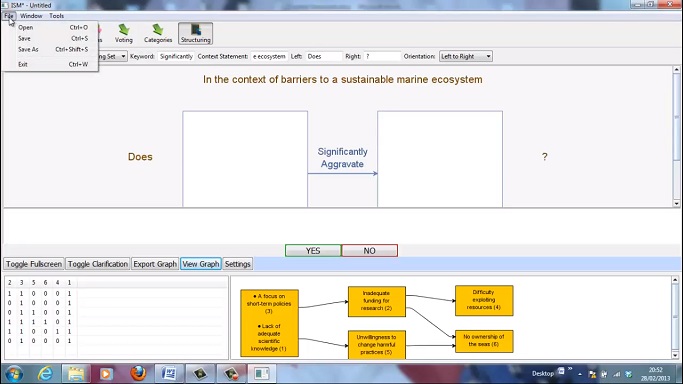 About ISM Software
About ISM Software
Many versions of software to implement Interpretive Structural Modeling have been written since the first one was developed at Battelle Columbus Laboratories in 1974. We are grateful to Dr. Benjamin Broome and Dr. Michael Hogan, who have made their Windows ISM software available for free download here.
The original MS-DOS-based software, along with a user's guide showing detailed examples, can be downloaded from George Mason University. However, this is of limited use as the source code has been lost, and the executables will not run on modern Windows platforms. We hope to rediscover the source code.
As the custodian of the Warfield legacy, the Trust is aware that other new ISM software using modern technology would be highly desirable, and we are supportive of any efforts in this direction.
Designers of the Windows ISM Software Available Here

Dr. Benjamin Broome is Professor at Arizona State University, USA. His research foci include group facilitation, consensus-building processes, intercultural and intergroup dialogue, and collaborative problem-solving. He has facilitated collective design processes with community groups, NGOs, corporations, indigenous communities, academic institutions, and government agencies in the Eastern Mediterranean, Western Europe, Black Sea region, Australasia, and North America.

Dr. Michael Hogan is a researcher and senior lecturer at NUI, Galway, Ireland. His research foci include individual, social and technology factors contributing to adult learning, motivation, and collaborative performance. He is a co-director of the Structured PhD in Perception, Cognition and Action, co-director of the Structured PhD in Learning Sciences, and co-leader of the Health and Well-being theme at the Whitaker Institute for Innovation and Social Change, NUI, Galway. Michael has facilitated collective design processes for a variety of EU projects focused on environmental sustainability, technology design, and business development.
List of publications:
Ruijer, E., Grimmelikhuijsen, S., Hogan, M.J., Enzerink, S., Ojo, A., & Meijer, A. (2017). Connecting societal issues, users and data. Scenario-based design of open data platforms. Government Information Quarterly.
Hogan, M., Ojo, A., Harney, O., Ruijer, E., Meijer, A., Andriessen, J., Pardijs, M., Boscolo, P., Palmisano, E., Satta, M., Groff, J., Baker, M., Détienne, F., Porwol, L., Scarano, V., & Malandrino, D. (2017). Governance, Transparency and the Collaborative Design of Open Data Collaboration Platforms: understanding barriers, options, and needs. In A. K. Ojo, & J. Millard (Eds.), Government 3.0: Next Generation Government Technology Infrastructure and Services. Springer.
Domegan, C., McHugh, P., Devaney, M., Duane, S., Hogan, M., Broome, B. J., et al. (2016). Systems-thinking social marketing: conceptual extensions and empirical investigations. Journal of Marketing Management, 1-22.
Dwyer, C. P., Hogan, M. J., Harney, O. M., & Kavanagh, C. (2016). Facilitating a student-educator conceptual model of dispositions towards critical thinking through interactive management. Educational Technology Research and Development, 1-27.
RezaeiZadeh, M., Hogan, M., O'Reilly, J., Cunningham, J., & Murphy, E. (2016). Core entrepreneurial competencies and their interdependencies: insights from a study of Irish and Iranian entrepreneurs, university students and academics. International Entrepreneurship and Management Journal, 1-39.
Hogan, M. J., Johnston, H., Broome, B., McMoreland, C., Walsh, J., Smale, B., Duggan, J., Andriessen, J., Leydon, K. M., Domegan, C., McHugh, P., Hogan, V., Harney, O., Groarke, J., Noone, C., & Groarke, A. (2015). Consulting with citizens in the design of wellbeing measures and policies: lessons from a systems science application. Social Indicators Research, 123, 857-87.
Groarke, J. M., & Hogan, M. J. (2015). Enhancing wellbeing: An emerging model of the adaptive functions of music listening. Psychology of Music, 0305735615591844.
Hogan, M. J., Harney O., & Broome, B. (2015). Catalyzing Collaborative Learning and Collective Action for Positive Social Change through Systems Science Education. In: Wegerif, R., Kaufman, J. Li L (eds). The Routledge Handbook of Research on Teaching Thinking. London: Routledge.
Hogan, M. J., Harney O., & Broome, B. (2014). Integrating Argument Mapping with Systems Thinking Tools - Advancing Applied Systems Science In: Okada, A., Buckingham Shum, S. & Sherborne, T (eds). Knowledge Cartography: Software Tools and Mapping Techniques. London: Springer.
Dwyer, C. P., Hogan, M. J., Harney, O. M., & O'Reilly, J. (2014). Using interactive management to facilitate a student-centred conceptualisation of critical thinking: a case study. Educational Technology Research and Development, 62(6), 687-709.
More...
 |
| John and Rose Warfield at a restaurant in Arlington, Virginia, 2004 |
John N. Warfield: An Autobiographical Retrospective
John Warfield's retrospective on Systems Science -- "Autobiographical Retrospectives: Discovering Systems Science" -- was published by Dr. George J. Klir, editor of the International Journal of General Systems 32(6), December 2003. For a free copy of the manuscript click here. For a copy of the published version (fee applies) click here.
As Warfield states in the introduction, "...my motivation was to develop a systems science: a science that extended all the way from its foundations through a sufficient number of applications to provide empirical evidence that the science was properly constructed and was very functional; a science that could withstand the most aggressive challenge.
The George Mason website agreed to provide a place for the Exhibits references in the article as a supplement to the text. Among other things, the Exhibits contain numerous pictures of individuals whose work contributes in some way to the development of systems science.
In his 2002 book "Understanding Complexity: Thought and Behavior", Dr. Warfield defines Interactive Management as: "A system of management invented explicitly to apply to the management of complexity. It is intended to be applied intermittently in organizations to enable those organizations to cope with issues or situations whose scope is beyond that of the normal type of problem that organizations can readily be solved."
This site is maintained by the Warfield Intellectual Property Trust. For more information about the Trust, or if you have comments about this site, please use the Contact Form.
This site is dedicated to the dissemination of the works and ideas of John N. Warfield (1925-2009), the Creator of Systems Science.
Dr. Warfield was the author of two U.S. patents on electronic equipment, and the inventor of Interpretive Structural Modeling, Interactive Management and Generic Design Science. He was the sole author of five books and co-author and co-translator of one book from German, as well as the co-author of over 100 papers. The subjects of these books and papers include computers, software, systems, organizations, electrical networks, interactive management and generic design science.
You are encouraged to explore this website to learn more about John N. Warfield's work. If you wish to gain greater understanding of his discoveries, please navigate to the Bookstore. |
Recent Books by Dr. Warfield Understanding Complexity: Thought and Behavior A comprehensive guide to Dr. Warfield's methods that have been successfully used in resolving problematic situations. Details the mathematical structure that underpins all of Dr. Warfield's work, including Interpretive Structural Modeling. |


